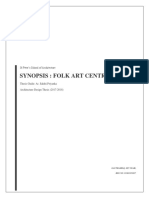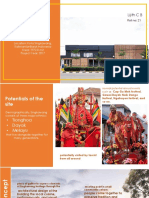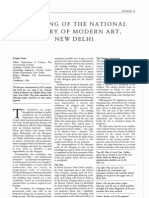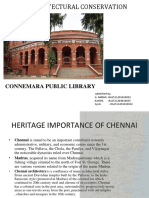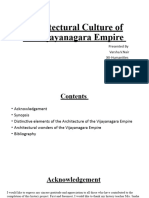0 ratings0% found this document useful (0 votes)
184 viewsArt & Cultural Center
Art & Cultural Center
Uploaded by
Archi-LeoThe document proposes developing a museum within the new Shree Kashi Vishwanath Temple Corridor in Varanasi, India. The museum would showcase the cultural and religious history of Varanasi and preserve ancient temples and artifacts. It would ease congestion in the area and provide amenities for pilgrims and tourists visiting the historic Kashi Vishwanath Temple. The museum site was selected due to its location along the new corridor connecting the temple to nearby ghats on the Ganges River.
Copyright:
© All Rights Reserved
Available Formats
Download as PPTX, PDF, TXT or read online from Scribd
Art & Cultural Center
Art & Cultural Center
Uploaded by
Archi-Leo0 ratings0% found this document useful (0 votes)
184 views29 pagesThe document proposes developing a museum within the new Shree Kashi Vishwanath Temple Corridor in Varanasi, India. The museum would showcase the cultural and religious history of Varanasi and preserve ancient temples and artifacts. It would ease congestion in the area and provide amenities for pilgrims and tourists visiting the historic Kashi Vishwanath Temple. The museum site was selected due to its location along the new corridor connecting the temple to nearby ghats on the Ganges River.
Original Description:
Art & Cultural Center at Varanasi
Copyright
© © All Rights Reserved
Available Formats
PPTX, PDF, TXT or read online from Scribd
Share this document
Did you find this document useful?
Is this content inappropriate?
The document proposes developing a museum within the new Shree Kashi Vishwanath Temple Corridor in Varanasi, India. The museum would showcase the cultural and religious history of Varanasi and preserve ancient temples and artifacts. It would ease congestion in the area and provide amenities for pilgrims and tourists visiting the historic Kashi Vishwanath Temple. The museum site was selected due to its location along the new corridor connecting the temple to nearby ghats on the Ganges River.
Copyright:
© All Rights Reserved
Available Formats
Download as PPTX, PDF, TXT or read online from Scribd
Download as pptx, pdf, or txt
0 ratings0% found this document useful (0 votes)
184 views29 pagesArt & Cultural Center
Art & Cultural Center
Uploaded by
Archi-LeoThe document proposes developing a museum within the new Shree Kashi Vishwanath Temple Corridor in Varanasi, India. The museum would showcase the cultural and religious history of Varanasi and preserve ancient temples and artifacts. It would ease congestion in the area and provide amenities for pilgrims and tourists visiting the historic Kashi Vishwanath Temple. The museum site was selected due to its location along the new corridor connecting the temple to nearby ghats on the Ganges River.
Copyright:
© All Rights Reserved
Available Formats
Download as PPTX, PDF, TXT or read online from Scribd
Download as pptx, pdf, or txt
You are on page 1of 29
Varanasi
gallery
At Shree Kashi Vishwanath
Corridor, Varanasi, Uttar Pradesh,
India
INTRODUCTION
• Kashi Vishvanath Mandir is one of the most
famous Hindu temples dedicated to Lord
Shiva. It is located in Varanasi, Uttar
Pradesh, India. The temple stands on the
western bank of the holy river Ganga, and
is one of the twelve Jyotirlingas, the holiest
of Shiva temples. The main deity is known
by the name Vishvanatha or Vishveshvara
meaning Ruler of The Universe. Varanasi
city is also called Kashi, and hence the
temple is popularly called Kashi Vishvanath
Mandir. Manikarnika Ghat is one of the
holiest among the sacred riverfronts
(ghats), alongside river Ganga. It is
believed that a dead human's soul finds
salvation (moksha), when cremated here.
Thus, scores of elderly people across the
whole country seek to walk up to its edges,
and spend their last days absorbing the
charisma of the ghat - which makes even
death painless and insignificant to be
pondered upon.
• There are also some interesting museums within the city of
Varanasi, displaying all kinds of artefacts from bygone days,
often of a religious nature. Just a matter of minutes from
Varanasi, the Sarnath Archaeological Museum is likely to be of
interest, as are the exhibits relating to the Maharajas of Banaras
within the city's famous Ramnagar Fort.
• This Museum cares and conserves a collection of artifacts, old
ancient temples at site, architectural important building and
other objects of artistic, cultural, historical importance of the
city.
FEASIBILITY OF PROJECT
• The museum is situated in Shree Kashi Vishwanath corridor.
• Shree Vishwanath Temple corridor, is proposed in the Old City
is located at the heart of Varanasi, between Dashashwamedh
Ghat and Godauliya to the south and west and Manikarnika
Ghat on the river to the north.
• The Kashi Vishwanath temple receives around 3000 visitors
every day. On certain occasions, the number reach 1000000
and more.
•Once the project
completed, the corridor will
ease the congestion and
provide the pilgrims and
travellers other amenities
such as wider and cleaner
road.
REQUIREMENT/AMENITIES
Typical schedule accomodation:
This includes exhibition rooms, auditorium, multiple-use event spaces
library, shop, workshops, conservation areas, offices, cafeteria, etc.
High quality lecture spaces and seminar rooms:
Extra income as conference suites.
Shop:
Should be accessible without having to enter the museum gallery.
At the same time, it should not be to dominant; shoppers have to
be reminded where the shop is.
Special temporary exhibitions:
These are important in attracting visitors to museums, which therefore
need to provide good facilities for such events. Particular need for
workshop access with clear wide access to the gallery, and also for
deliveries, from the strret, of construction materials and loaned objects
in large crates.
Resources centre:
In main gallery space or store area, where researchers can handle and
examine objects under controlled environmental condition and approved
supervision.
• Entrance:
• This can be accessible and democratic or ceremonial and
imposing. An entrance at ground level is welcoming.
• Visitor orientation:
• The visitors need a clear idea of the layout of the
exhibition rooms.
A central atrium:
Interconnecting all rooms with a central atrium
enables visitors to orient themselves and choose the
rooms they wish to visit.
•Access for people with disabilities:
•A separate route for wheelchair.
•Ramp for changing the level.
•Lift device, stair lift and a platform stair.
•WCs for disabled users at all level.
Staff needs access is required for staff with disabilities to all
offices and stores, with accessible toilet facilities on the
office level. This would open up this areas to disabled
students, researches and colleagues from elsewhere
wishing to study items in store.
NEED OF THE PROJECT
• Planning and development and implementation of
heritage-sensitive infrastructure.
• Service providing and infrastructure provisioning in the
core area of the historic city.
• Preserve and revitalise heritage where, tourists can
connect directly with the city’s unique character.
• Developing and documenting heritage asset inventory
of cities – natural, cultural, living and built heritage as a
basis for heritage growth, local handicraft and
architecture.
• Local capacity enhancement for the inclusive heritage-
based industry.
LOCATION
Shree Kashi Vishwanath
Temple Corridor
proposed site, Varanasi,
Uttar Pradesh, India.
Geographic coordinates:
25°18′38.79″N
83°0′38.21″E
SITE SELECTION
• The site is located in Shree Kashi
Vishwanath Temple Corridor.
• Site is facing a 50 feet wide corridor
which directly connect Ganga’s
Manikarnika as well as the Lalita
Ghat to the Kashi Vishwanath
Jyotirlinga Temple.
• Devotees and travellers will witness
a newly built museum as well as an
auditorium depicting Varanasi’s
ancient history and culture
• Site area: 17000 sq. mt.
OBJECTIVE
• This 700-meter corridor that can potentially accommodate 3,000 devotees
at a time, is apparently being built to enhance “comfort levels” of the
devotees. It will connect the Kashi Vishwanath Mandir to the Ganga (near
the Lalitha ghat), the idea being that devotees can take a holy dip in the
Ganga and come directly to have darshan of Kashi Viswanath.
•The gallery would showcase the sites,
history, and culture of Kashi along with
information on the important places in
and around Kashi.
•Museums serves detail about the
breaking down of old structures
including possibly heritage structures,
shrines and murtis and save them.
•Museum would play an important role
to host to several high profile tourist,
local tourists and foreigner tourists.
FUTURE ASPECTS
Pilgrims will get direct access to KVT from Manikarnika Ghat, Jalasen and
Lalita Ghats through this corridor.
Economic growth.
Develop infrastructure.
Increase tourists.
Entry of VIP vehicles, physically chalenged persons will become possible
through chhattadwar point.
46 ancient temples, library and buildings of architecture importance to
be preserved in corridor which provide deep knowledge about the Holy
city.
POSSIBILITIES
Schools
After school
Groups
and community
Visitors in Families
museum
Elderly
Tourists
Young adults
• Preserve ancient temples and artifacts.-
• New inclusive public spaces, new infrastructure, new
facility provide to tourists and locals in the core of city.
Case study
national gallery of modern art,
new Delhi
literature study
bharat bhawan,
Bhopal
Site analysis
Varanasi, uttar pradesh
thankyou
You might also like
- Ritual 2 Turning Attraction Into LoveDocument2 pagesRitual 2 Turning Attraction Into Lovekrlup50% (2)
- Living by Faith A T Jones E J Waggoner PDFDocument112 pagesLiving by Faith A T Jones E J Waggoner PDFRey John Nullas Monje100% (2)
- Solicitation Letter Youth CampDocument1 pageSolicitation Letter Youth CampAna Rica Santiago Navarra-Cruz90% (10)
- SYNOPSISDocument6 pagesSYNOPSISNavya VenkateshNo ratings yet
- Virasat e Khalsamemorial 170216093911Document10 pagesVirasat e Khalsamemorial 170216093911riddhiNo ratings yet
- Art and Culture Hub A Thesis Report: Akhila LDocument54 pagesArt and Culture Hub A Thesis Report: Akhila LPRINCESS PNo ratings yet
- Primary Case StudyDocument6 pagesPrimary Case StudyShreshth SharmaNo ratings yet
- Artisan'S Village, Jaipur (Raj.)Document9 pagesArtisan'S Village, Jaipur (Raj.)aditi goenkaNo ratings yet
- Bharat BhavanDocument15 pagesBharat BhavanArchi. club0% (1)
- IndraprasthaDocument7 pagesIndraprasthaLiza Gilani100% (1)
- Delhi Haat 1aDocument1 pageDelhi Haat 1aJacob WarrenNo ratings yet
- Thesis Synopsis 2017Document7 pagesThesis Synopsis 2017Sanjana AppachuNo ratings yet
- Bharat BhawanDocument15 pagesBharat BhawanGaurav Sharma100% (3)
- Thrissur Heritage Project Concept Presentation 11 CompressedDocument103 pagesThrissur Heritage Project Concept Presentation 11 CompressedBOOMINATHAN KARUNAKARANNo ratings yet
- Nivi Dialogue With The Past - Cultural & HeritageDocument9 pagesNivi Dialogue With The Past - Cultural & Heritagenivetha jayaramanNo ratings yet
- Thesis Guide:: Ar .Nida Hasan Ar - Zenab SamreenDocument7 pagesThesis Guide:: Ar .Nida Hasan Ar - Zenab SamreenArslaan AlamNo ratings yet
- NEW Cultural Centre Synopsis PDFDocument32 pagesNEW Cultural Centre Synopsis PDFROHIT GUPTA100% (1)
- Faculty of Architecture and Planning, Aktu, Lucknow: 5 MuseumsDocument6 pagesFaculty of Architecture and Planning, Aktu, Lucknow: 5 MuseumsTushar SharmaNo ratings yet
- Bharat BhavanDocument6 pagesBharat BhavanVedangi Kale100% (1)
- Enlivening The Folklore A Case of Channapatna, KarnatakaDocument4 pagesEnlivening The Folklore A Case of Channapatna, KarnatakaSNEHA DEVARAJUNo ratings yet
- Folk ArtDocument4 pagesFolk Artmonika senthil100% (1)
- Interpretation Centre: Junnar Is A City With Thousands of Years of History in The Pune District of The Indian State ofDocument2 pagesInterpretation Centre: Junnar Is A City With Thousands of Years of History in The Pune District of The Indian State ofRidhi SaxenaNo ratings yet
- SYNOPSISDocument8 pagesSYNOPSISRevathy NandaNo ratings yet
- Thesis Topic 1Document10 pagesThesis Topic 1krishna KRISHNo ratings yet
- The Cultural Promenade - Thesis 2015' - Case Study On Arts (Artist Village) - Comparative Analysis Hindustan University Entry SpacesDocument5 pagesThe Cultural Promenade - Thesis 2015' - Case Study On Arts (Artist Village) - Comparative Analysis Hindustan University Entry SpacesManimegalai PrasannaNo ratings yet
- Thesis Synopisis - Tanuj Goyal (15bac009)Document20 pagesThesis Synopisis - Tanuj Goyal (15bac009)Tanuj GoyalNo ratings yet
- Vasant KunjDocument3 pagesVasant Kunjyaman raoNo ratings yet
- Thesis End HK PDFDocument142 pagesThesis End HK PDFHarkunwar SinghNo ratings yet
- Book Study: Kadare Cultural CentreDocument25 pagesBook Study: Kadare Cultural CentreShabnamNo ratings yet
- Case Study BBDocument27 pagesCase Study BBRiddhi ShrivastwaNo ratings yet
- Cultural CentreDocument17 pagesCultural CentrechaithanyaNo ratings yet
- Cultural Centre Case StudyDocument19 pagesCultural Centre Case Studylijith cbNo ratings yet
- Case Studies: International Convention CenterDocument51 pagesCase Studies: International Convention CenterKãřtĭk KĥuřanaNo ratings yet
- Kalaacademygoa1 160807064934Document15 pagesKalaacademygoa1 160807064934Rio RaHulNo ratings yet
- Thesis Synopsis Kutch 2019Document4 pagesThesis Synopsis Kutch 2019Srirang Girish67% (3)
- Bharat Bhavan BhopalDocument18 pagesBharat Bhavan BhopalPrachi RathoreNo ratings yet
- Thesis On Craft S Vlllage Madhyapur ThimDocument98 pagesThesis On Craft S Vlllage Madhyapur ThimSri SandhiyaNo ratings yet
- Request For Proposal Development of Tagore Cultural Centre at ...Document39 pagesRequest For Proposal Development of Tagore Cultural Centre at ...rubanraj r (RA1811201010009)No ratings yet
- Cultural and Heritage CentreDocument7 pagesCultural and Heritage CentreAmalShankarNo ratings yet
- Kala Academy Case Study NewDocument18 pagesKala Academy Case Study NewSHYAM ANo ratings yet
- Afsha KhanDocument9 pagesAfsha KhanSaniya AhmadNo ratings yet
- NGMADocument4 pagesNGMAGeetanjali KhannaNo ratings yet
- Chapter 1-2Document22 pagesChapter 1-2Lain PadernillaNo ratings yet
- Artisan VillageDocument31 pagesArtisan VillageSanchita JhaNo ratings yet
- Dillihaat Ina 160208123859Document35 pagesDillihaat Ina 160208123859Dhivya bnrNo ratings yet
- Athulya B Raj, B17arb08 (Thesis Topic)Document4 pagesAthulya B Raj, B17arb08 (Thesis Topic)ATHULYA B RAJNo ratings yet
- Ad Charles Correa PDFDocument18 pagesAd Charles Correa PDFbalaji SNo ratings yet
- SYNOPSIS FOR THESI KalaDocument17 pagesSYNOPSIS FOR THESI KalaHimanshu SainiNo ratings yet
- Bharat BhavanDocument21 pagesBharat BhavanEtee Agrawal0% (1)
- Indraprastha Kala Sanskriti Kendra: Topic For Architectural ThesisDocument8 pagesIndraprastha Kala Sanskriti Kendra: Topic For Architectural Thesisvaibhavi pendamNo ratings yet
- Thesis Synopsis PDFDocument6 pagesThesis Synopsis PDFAzrah FathimaNo ratings yet
- Architectural Design 4 Literature StudyDocument6 pagesArchitectural Design 4 Literature StudyPunniya100% (1)
- Panaji, Goa: Kala AcademyDocument11 pagesPanaji, Goa: Kala Academyzohra hussainNo ratings yet
- Z Thesis SynopsisDocument22 pagesZ Thesis SynopsisAfsheen NaazNo ratings yet
- SynopsisDocument22 pagesSynopsisRehan TarafdarNo ratings yet
- Triveni Kala Sangam DwgsDocument4 pagesTriveni Kala Sangam DwgsRohit_Bhutada_3047No ratings yet
- Bharat B HwanDocument16 pagesBharat B HwanDeepa Sharma50% (2)
- Craft Document GoaDocument141 pagesCraft Document GoaBhavik RangaNo ratings yet
- Artist HubDocument10 pagesArtist HubspremkumarNo ratings yet
- The senses in interior design: Sensorial expressions and experiencesFrom EverandThe senses in interior design: Sensorial expressions and experiencesNo ratings yet
- Varanasi CityDocument12 pagesVaranasi CityPoorva PriyadarshiniNo ratings yet
- ATOMMMDocument13 pagesATOMMMNidz ReddyNo ratings yet
- Architectural Culture of The Vijayanagara EmpireDocument29 pagesArchitectural Culture of The Vijayanagara Empirevarshanair491No ratings yet
- Islam The Ancient Near East and Varieties of Godle... - (Chapter 3. Idrīs Atraḫasīs and Al-Khiḍr)Document38 pagesIslam The Ancient Near East and Varieties of Godle... - (Chapter 3. Idrīs Atraḫasīs and Al-Khiḍr)ali0719ukNo ratings yet
- The Fall of Rhodes and Its ColossusDocument4 pagesThe Fall of Rhodes and Its ColossusTolkienReader1No ratings yet
- Grace Phil Wickham BB PDFDocument2 pagesGrace Phil Wickham BB PDFYerson VenturaNo ratings yet
- (NT3) PaulineTheology Centre of TheologyDocument2 pages(NT3) PaulineTheology Centre of TheologyparliamentNo ratings yet
- Understanding Spiritual Leadership (Ptr. Ramon Batul)Document4 pagesUnderstanding Spiritual Leadership (Ptr. Ramon Batul)Criztal joy PascuaNo ratings yet
- Embercombe Course Waking DragonsDocument19 pagesEmbercombe Course Waking DragonsWitchruna HaljarunaNo ratings yet
- Contracts II Final OutlineDocument24 pagesContracts II Final Outlinepmariano_5No ratings yet
- MythologyDocument20 pagesMythologyPAssentNo ratings yet
- SMITH WIGGLESWORTHDocument143 pagesSMITH WIGGLESWORTHMAIRTON DE OLIVEIRA MELONo ratings yet
- (E.a The Grimoire of Amaymon (Nine Demonic Gatekeepers Book 2Document27 pages(E.a The Grimoire of Amaymon (Nine Demonic Gatekeepers Book 2Ṩĸṳlḷ Kȉď67% (6)
- 10 Commitments To Your SuccessDocument101 pages10 Commitments To Your SuccessDobrescu AncaNo ratings yet
- The Only GodDocument10 pagesThe Only GodtiandwiNo ratings yet
- Family Law 2 Final DraftDocument20 pagesFamily Law 2 Final DraftNiharika Bhati50% (2)
- Ács - Hungarian Bible - JpmcorrDocument20 pagesÁcs - Hungarian Bible - JpmcorrÁcsPálNo ratings yet
- What Are The Main Characteristics - of Vietnamese History Culture?Document3 pagesWhat Are The Main Characteristics - of Vietnamese History Culture?Gia NghiNo ratings yet
- K.Szpakowska, Demon Things. Ancient Egyptian Manifestations of Liminal Entities, in JAEI 25 (2020)Document3 pagesK.Szpakowska, Demon Things. Ancient Egyptian Manifestations of Liminal Entities, in JAEI 25 (2020)MartinaNo ratings yet
- English Sindh Text Book Board For Secondary 1Document61 pagesEnglish Sindh Text Book Board For Secondary 1Ibrahim Ahmed100% (2)
- Then Nang UrDocument4 pagesThen Nang UrAnnette MeyerNo ratings yet
- Human Act Act of Man Versus Human ActDocument2 pagesHuman Act Act of Man Versus Human Actgiezele ballatan100% (1)
- Conversion Programme: Rabbinical Council of America - Montreal RegionDocument4 pagesConversion Programme: Rabbinical Council of America - Montreal RegionAnderson Santillan MacielNo ratings yet
- Villagonzalo VDocument2 pagesVillagonzalo VKite NavarroNo ratings yet
- DhundharDocument5 pagesDhundharAarti ChandrawatNo ratings yet
- Nilai Pat Kelas X-IpaDocument31 pagesNilai Pat Kelas X-IpaAmadeo gallvinNo ratings yet
- MacrobioticDocument32 pagesMacrobioticRanya Samir DarwishNo ratings yet
- What To Do With The SeedDocument3 pagesWhat To Do With The SeedDhon ReyesNo ratings yet
- MarkEpstein TheTraumaofEverydayLifeDocument5 pagesMarkEpstein TheTraumaofEverydayLifeDann' Mendoza Ü100% (1)
- Hamlet Self InterestDocument2 pagesHamlet Self Interestloceci0518No ratings yet




















